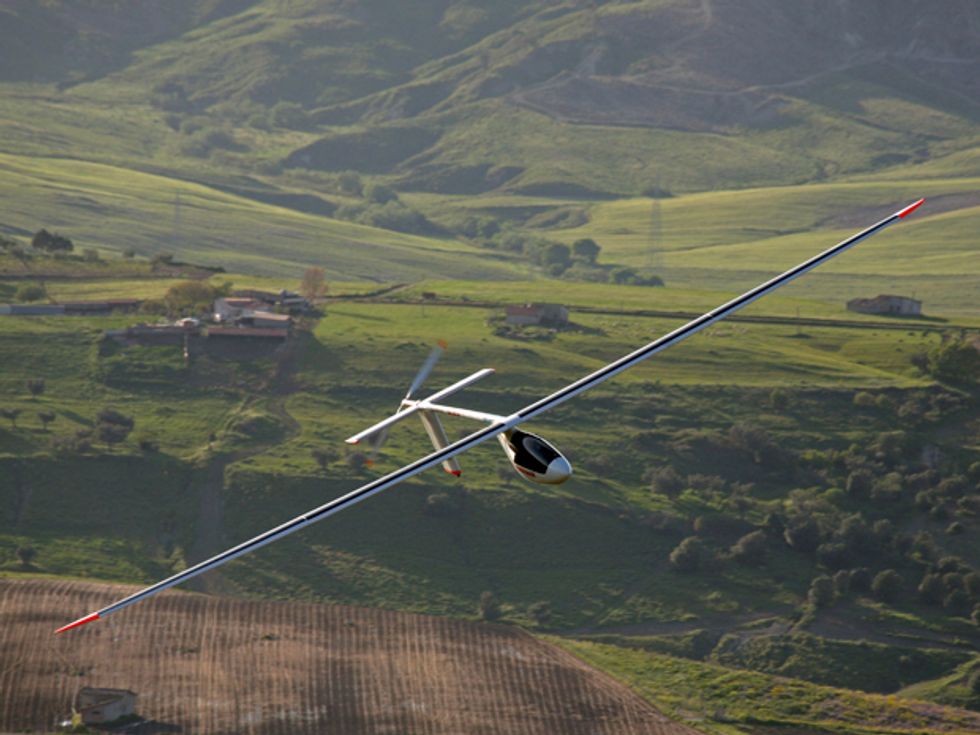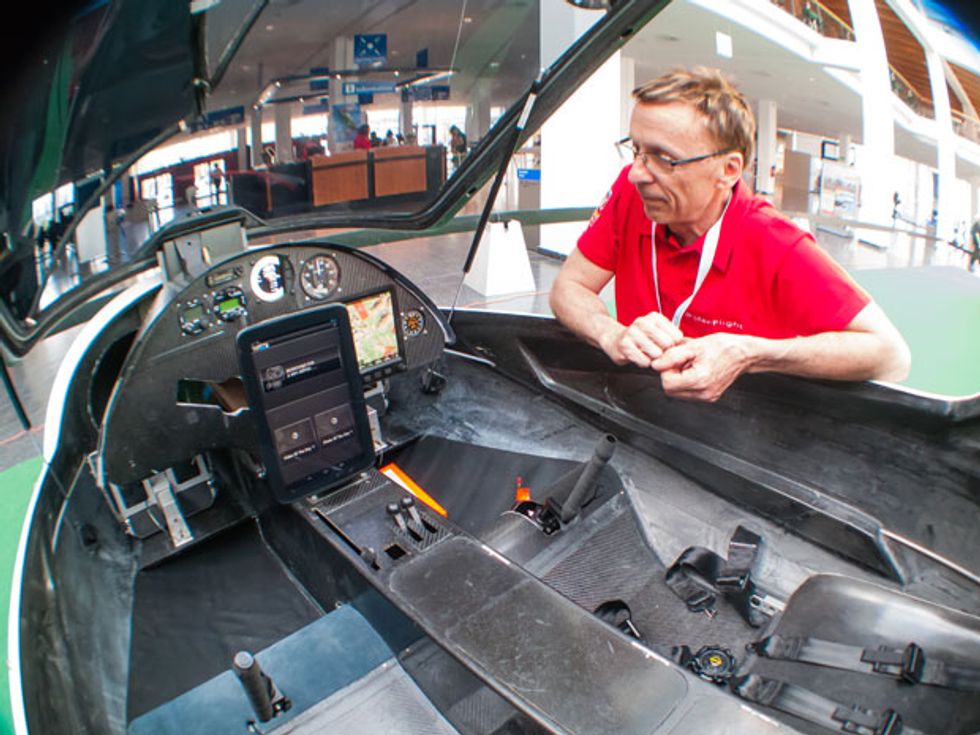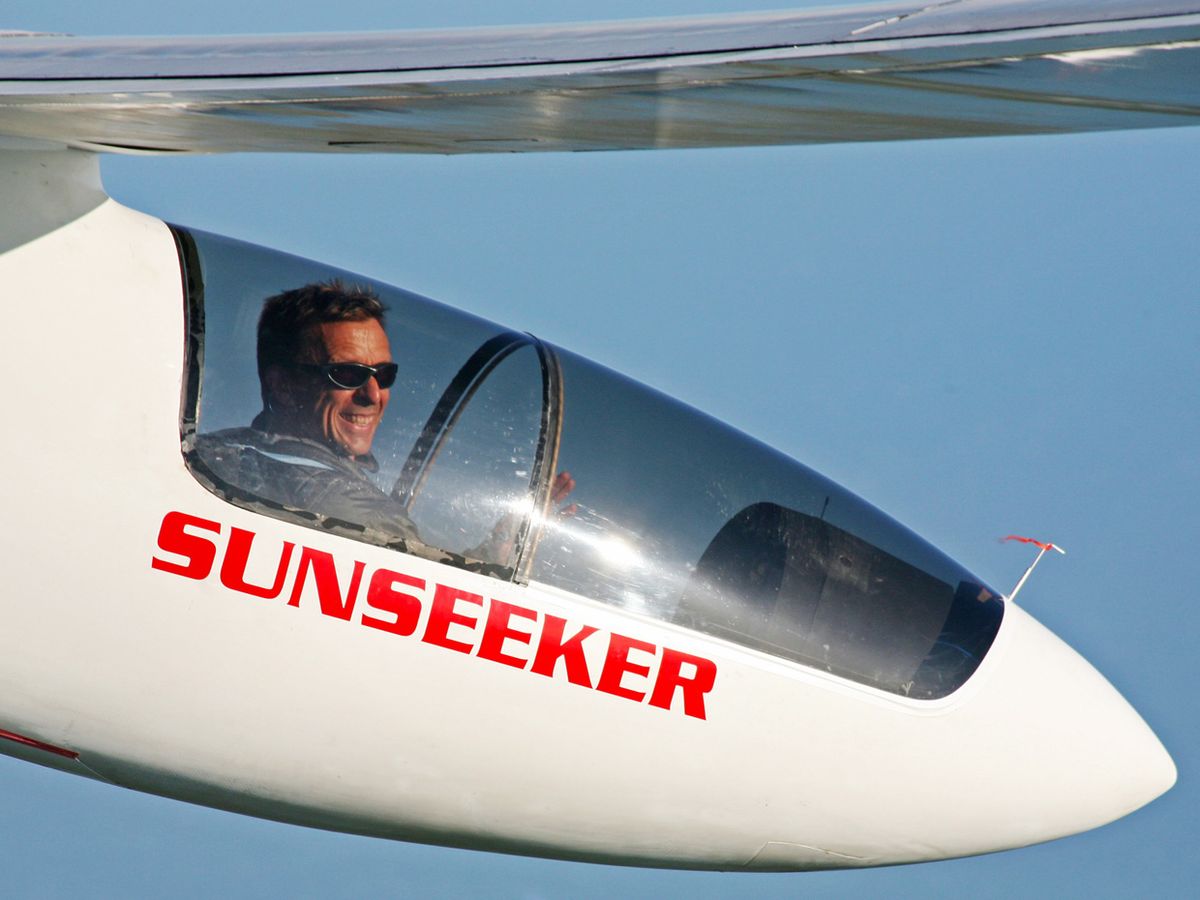Last month, the photovoltaic-powered plane Solar Impulse completed its six-stage, two-month journey across the United States. It wasn’t quite Armstrong on the moon or Lindbergh in Paris, but it was still a rather significant aeronautical achievement.
What’s often forgotten is that the Solar Impulse wasn’t the first solar plane to cross the United States. In the summer of 1990, 23 years ago, the Sunseeker performed a similar feat. Designed and flown by Eric Raymond, then a 33-year-old California engineer, Sunseeker flew across the country, making 21 stops over the course of a summer, spending 121 hours in the air.
It bears remembering how far away 1990 is in terms of technology. The latest cellphone was the bulky Motorola MicroTAC. The must-have computer was the Amiga 3000. The 1990 Sunseeker had amorphous silicon solar cells whose efficiency was just about 2 percent. There were almost 11 square meters of them, on the curvy top part of the wings, the tail boom, and the tailplane. The motor produced a paltry 2.4 kilowatts.
By comparison, the Solar Impulse is a giant. It was able to cross the United States in only six long stages, because it’s able to fly at night. The plane is much bigger, both in mass (1600 kilograms) and wingspan (63.4 meters). It’s powered by four 7.5-kW engines. The power train, whose total efficiency is rated at 12 percent, is powered by 200 m2 of solar cells.
To get a feel for what the 1990 expedition was like, IEEE Spectrum contributor Michele Travierso sat down with Raymond and watched a grainy video. Originally recorded on VHS tape, the footage was provided by Sanyo, the main technical sponsor and provider of the solar cells. In it we see a man in light blue shorts, a white shirt, a cowboy hat, and those funny wraparound sunglasses that were popular at the time. The man, Kenji Bamba—a friend of Raymond’s from hang-gliding—is starting to push a light aircraft from the back of the cockpit. As the airplane picks up momentum, the pilot starts the electric engine that’s nested in the back of the fuselage pod, making the propeller blades—until now folded gracefully backward—spread open. From the feeble pace of acceleration, we can infer the reason for this push: The plane couldn’t have budged by itself. The noise is minimal—only the gentle whirring of the slow-rotating propeller cutting through the air, just enough to sustain the forward motion and, eventually, a gentle climb. It marks the beginning of the trip.

Michele Travierso: How did you get into this?
Eric Raymond: I got the idea of flying around the world by solar power in 1986, but in 1988 I got a sponsor from Japan, and they proposed I fly around the United States first. So we did the United States in the summer of 1990. It was a group of Japanese companies—Sanyo, Subaru, and others. It was a bit mystifying, because some of the money was stolen before it left Japan.
Michele Travierso: Stolen?
Eric Raymond: I had this alcoholic agent who was selling US $40 000 sponsorship packages, and he sold a lot of them, and he didn’t tell me. I found out about it only later.
Michele Travierso: How did you happen to find sponsors in Japan?
Eric Raymond: They had a lot of money and a lot of interest in the future. I had a Japanese friend from hang gliding, Kenji Bamba. He and I were in Japan for a hang-gliding competition in the late 1980s. We decided to sell the idea of a solar-powered airplane in Japan, and it was working very well.
I was building hang-gliding harnesses at the time. In 1986, I flew the world’s fastest human-powered airplane, the Musculair II. I wanted to do a solar-powered airplane in 1979, but I had no shape [in mind].
Michele Travierso: And you worked with the legendary Alan Cocconi, right?
Eric Raymond: I didn’t involve Alan Cocconi until the airframe was finished. There were some very important people involved from the beginning, helping me design various parts. The designer of the Musculair II, Günther Rochelt, gave me a lot of his data as the starting point, which is good—same airfoil, same wing chord. His children were both hang-glider pilots. I just went to see him in Germany because people told me I really should meet him and he’s amazing. And he was. So he invited me to fly the Musculair II, and I met up with him in Vancouver, Canada, where he was demonstrating it at Expo 86.
Michele Travierso: And how was Sunseeker progressing?
Eric Raymond: We were gliding Sunseeker in 1989, but without the motor. We put in the motor in January or February 1990, and it was good enough. We put in a new motor in April or May. It was just ready in time.
So for a solar panel, there’s only one way to get the maximum power out of it. You need this active DC-to-DC converter called MPPT, for maximum power point tracker. It was invented by Alan Cocconi. The MPPT is the most important thing. It connects the solar cells to the batteries. It finds, well, the peak power point. There’s this curve with basically zero power at one end and zero power at the other end, and somewhere in the middle there’s an obvious maximum power. It’s obvious for someone looking at the graph, but you have to write a program on the microchip to do this algorithm, to dither around and find [the peak power].
You have to remember, this is much more complex than solar panels on the roof of a house, which might just have some clouds or something go by. This has the airplane moving; the temperature is changing, the batteries’ voltages are changing. We have all these different conditions. Alan worked on the motor controller, too, but he didn’t design it. He helped me modify it somewhat.
Michele Travierso: And why is it difficult? There’s lots of fine-tuning involved?
Eric Raymond: It’s difficult to convert the power from one voltage to another efficiently, and we are talking about 97 percent efficiency. There’s lots of ways you can do things in electronics, you know, using resistors or something. If you really want efficient design, you don’t generate too much heat, you don’t waste electricity, so it seems to be quite difficult to make it right. Alan invented the MPPT in about 1987.
Michele Travierso: What about the cells?
Eric Raymond: Sunseeker I had amorphous crystalline solar cells. They generated 250 watts and were only 2.1 percent efficient. I think it was only 10.8 m2 of cell surface. The engine was 2.4 kW at the time, which is not much. Now the same airplane has 5.5 kW. [Editor’s note: Raymond has upgraded the electronics and batteries of the Sunseeker a number of times, the latest in 2009.] It was powered by 96 nickel-cadmium D-cells soldered together. The battery pack was less than 15 kg. The solar panels were not doing much, just recharging the batteries, really. We use high voltage, because the higher the voltage, the lower the losses. It’s dangerous: If you disconnect the connectors slowly, you can pull an arc like a welder through the air, ionizing the air. In fact, it will just burn. Even aluminum burns. I’ve heard of lots of accidents.

Michele Travierso: If you had to name the one biggest technological development since the 1990 flight, what would it be?
Eric Raymond:Lithium batteries. I mean, solar cells are much better, too, but even bigger than that, it’s lithium batteries. It’s tremendous. I mean, we never heard of lithium. I seem to remember that my latest battery pack is seven times better than my first. Here’s a simple comparison: The nickel-cadmium ones were 4.4 ampere-hours. In 2006, I switched to lithium polymers that were 11 Ah, and now I’ve switched in 2009 to 16 Ah, and at the same time I keep going up in the number of cells. So voltage and current can go up. This gives an idea of the capacity.
The glide ratio of the Sunseeker is about 35 or 36 to 1. [Editor’s note: It can glide for 35 or 36 kilometers from a height of 1 km.] I could sustain level flight with 1 kW at the beginning, but now the same aircraft is heavier, so it must be at least 1.5 kW. The Duo [Raymond’s latest version of the plane] should be between 3 and 4 kW, and the solar cells make 4.5 kW. I can climb on solar power, too—not at full weight and with optimal conditions, but I can.
Michele Travierso: Back to the trip.
Eric Raymond: We were going to start right from San Diego, but the Air Force had this hideous circus going on. So we went back to our favorite testing site, which is in the middle of California. It’s called Desert Center, near Palm Springs. The first flight was from there to Phoenix, and the next day we flew to New Mexico. We were doing about a state per day. Once we got into Missouri, which is a big hazy, humid state, we made much slower progress going east.
In fact, my progress slowed so much that in West Virginia I saw the same three birds for two days in a row. I think we became good friends. I was determined to get over the Appalachian Mountains, and my best option for avoiding the mountains and controlled airspace was to circle up into a cloud, and these three birds were following me. They were staying very, very close, at times within a meter of my window in the cloud. It was great.
Even though the Appalachians weren’t the highest mountains we crossed, it was the most challenging. We just didn’t have good solar power or visibility. I could fly around, but I had to gain altitude, and I was just hanging on. I was trying to work my way up to get over the mountains. It’s not even a matter of going over the mountains—it’s getting over the mountains safely, where you can glide to an airport on either side.
Michele Travierso: What safety precautions did you take?
Eric Raymond: I had a ballistic parachute system—one that when fired saves the whole airplane, not just the pilot. I had a car and an airplane following me all the way. And I wore a very lightweight backpack parachute too, so I had two parachutes—one for the airplane, one for me.
Michele Travierso : What about the flight planning? What constraints did you have?
Eric Raymond: We were just looking for little airports, preferably with hangars. It was for me, like, fly all day, every day, trying to find a restaurant in the evening and fly the following day. It was 21 stops, 121 flight hours. We had a lot of headwind and not-so-nice weather. There was a high pressure system sitting over the United States, spinning around in such a way that it would make east winds, which is very unusual. I was planning to land at the First Flight Airport. It is on North Carolina’s Outer Banks, which is in reality is a very long, thin sand island, but it’s got a lot of pine trees, especially around the airport. When we got there, there was the first storm of the season coming, with strong northeasterly winds, which was crosswind at that airport. I would have been ashamed to land the Sunseeker there and crash it because of strong crosswinds. It would have been the last stop, but we stopped at Spot, N.C. It’s just as far, just on the mainland. You don’t have to go on a ship or a bridge or anything.
Michele Travierso: What was the most arduous moment of the adventure?
Eric Raymond: Missouri was really difficult. I flew over 100 miles below 1000 feet, and then there was a hilly terrain I couldn’t make it over, and I made a landing in a field—basically it’s the top of this hill—and I broke the wheel landing. The funny thing was that there were all these Japanese sponsors along, and they couldn’t pronounce Missouri, and they would say, “Are we still in the Mi-se-ry?” “Yes, we are still in the Misery.” Missouri became misery.
Michele Travierso: I read that the arrival was a bit anticlimactic.
Eric Raymond: I thought I was going to be seeing the Atlantic Ocean—you know, brilliant sunshine—but it was actually cloudy and light rain.
Michele Travierso: And why do you think very few people know about this amazing adventure?
Eric Raymond: The sponsors were disappointed by the publicity, because the war in Iraq started right about the beginning of the flight. [Editor’s note: Iraq invaded Kuwait on 2 August 1990.] I was left in debt for about three years.
About the Author
Michele Travierso, a writer based in Shanghai, says he got the airplane bug when he was 4 years old. Now a licensed glider pilot, he has been following the electrification of such aircraft intently. In the July 2013 issue, he reported on 10 electric planes to watch.
